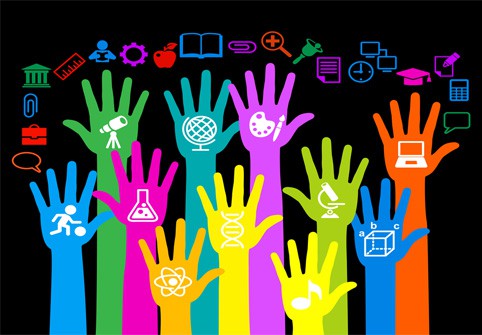SMARTtech Roundup: From Blended Learning to Big Data

Blended Schools & Tools
Blended Schools Sprouting. Vail Blended Learning is a new blended middle school in Arizona that uses laptops as its main learning tool using online content developed by K12 Inc., e2020, and VBL Curriculum and Instruction. Students have a flexible daily schedule and move through self-paced coursework. A new blended learning public high school is also opening up in Michigan. The Nexus Academy in Okemos will be a physical version of a virtual high school, combining online courses with face-to-face instruction. Speaking of cool blended schools, did you see Tom’s case study on Leadership Public Schools on EdWeek?
More and better opportunities. Public Impact released new financial analyses that show how redesigned teacher roles can extend the reach of excellent teachers to more students and free funds to pay those teachers up to 130 percent more. In some variations, schools may pay all teachers more while providing new, varied roles and sustainably funded career paths.
New from Knewton. A new white paper from Knewton clarifies the definition of adaptive learning and the theories that drive the work of “building the world’s most powerful recommendation engine for education.
Gates on GBL. In an interview with the Atlanta Journal-Constitution, Bill Gates said that students are motivated by engagement with technology like gaming and this motivation can be directed toward learning. Over the last two years, the Gates Foundation has brought together education experts and video game designers to help plan how such game-based learning can be implemented.
(Want more Blended Learning? Check out our list of 60+ Top Articles the topic.)
Digital Developments
Get Amped! News Corp launched Amplify. Amplify is a new business dedicated to reimagining K-12 education by creating digital products and services that combine engaging curriculum with rigorous analytics and new delivery mechanisms. Joel Klein’s talented team is also working with AT&T to deliver a 4G mobile tablet-based experience that will enhance teaching and learning for grades K-12.
Digital Prep. Prepmatic is launching Monday with an offer of free trials for low income schools. They are targeting 15-18 year old SAT takers with their system for learning vocabulary through adaptive tools and progress monitoring.
Zoom Zoom. To access the current bandwidth of America’s schools, San Francisco-based nonprofit EducationSuperhighway aims to get 10 or more people at every American school to run a speed test. The nonprofit will collect the data, share it back with the relevant schools, districts and states — and release aggregated numbers.
USA! USA! Little River News reported on the Olympic hopefuls who are going for the gold with virtual school educations through Connections Academy to fit their training and competing schedules.
EdTech and EarlyEd. ECS released The Progress of Education Reform: Technology in Early Education . The report explores building platforms for connections and content that strengthen families and promote success in school.
Global Positioning. Movements toward the digital future of education made headlines in India and Zimbabwe this week. 1,000 Zimbabwe schools will have e-learning courses by 2013. Reports indicate that the Online Education market in India will double to $40 Billion in the next five years.
The unconference conference. Colorado instructional-technology director Monique Flickinger shares the “unconference” way to help teachers learn about technology in her blog post about her experience at her first “unconference” and offers 10 ideas for helping teachers learn about technology. Ideas include creating short podcasts showing teachers using tech tools with students, tweeting quick tips to teachers, teaching each grade level a different mobile application, and having tech “smackdowns” by taking time to share information on apps and Web tools at the end of staff meetings.
The Science of Getting Smart
Creativity in Cincinnati. A cool project at the University of Cincinnati (Go Bearcats!) will work to identify the patterns of how creativity happens and how to encourage it. The National Science Foundation has given just under $1 million to the project as one of the agency’s first Interdisciplinary Research and Education (INSPIRE) grants.
Kinecting for Kids. Sesame Street and Nat Geo are now available on Kinect. In an innovative TV experience Kinect Sesame Street TV and Kinect Nat Geo TV will both launch on September 20th, 2012. Alex Games, Ph.D., curriculum and learning sciences expert and educational design director for Microsoft said in October, “We know that the most effective learning environments for children are those that are engaging and exciting, and that foster collaboration and a positive attitude toward learning,”. Games said “With the controller-free magic of Kinect, we can encourage kids to use their motor skills and to learn using their body in immersive experiences. This new way to play allows children to learn by interacting with their favorite characters and engage with content in novel ways.”
Girls and Inquiry. Learning sciences doctoral student Danielle Keifert won the award for best student paper at a recent international conference in learning sciences. Her paper documents the ways in which very young children encounter opportunities for scientific inquiry in their everyday lives.
Steamy STEM Gems
Thanks Sally! Sally Ride—the first American female astronaut and an influential role model and advocate for STEM education—died this week from pancreatic cancer at age 61. Maureen Downey paid tribute and explored her impact on science education.
What do you think? Michigan’s Dave Murray explored the question: Should teachers be paid more for student performance or teaching STEM subjects?
Energy Education. Oklahoma teachers this week participated in hands-on lessons they can use to teach students about the state’s gas and oil industry. While early childhood educators played a game called Road to Petroville, teachers of grades 3-6 made compost mixtures showing how sedimentation and gas vapor develop underground. A distillation experiment done by math and science teachers demonstrated how the refining process turns crude oil into gasoline.
Getting to the Core
PARCC, SBAC and ACT. ACT, Inc., is launching a “next generation assessment system” that sure looks like a competitor to new consortia tests being developed on the same timeline and shooting for the same $20 price point. ACT Education President Jon Erickson said, “It’s being designed to meet both states expressed needs as well as reflect what our research indicates is important.”
TeachFest. Through support from the Gates Foundation, LearnZillion TeachFest brought over a 100 teachers together for three days to begin creating the next batch of amazing Common Core lessons – this time in Math (grades 3-9), and English Language Arts (grades 3-8), including reading, writing, grammar, phonics, and idioms.
Common Criteria. EdWeek reported on the writers of the Common Core State Standards in math that have finalized guidelines for curricular materials that seek to promote “faithful” implementation of the new standards for grades K-8, noting that “the document is intended to guide educational publishers in developing textbooks and other instructional materials, as well as states and districts as they evaluate and select materials or revise existing ones.”
Come On Get App-y
PBS Tips. Iowa Public Television’s educators, in conjunction with PBS Parents, are offering tips to help guide parents’ decisions when selecting educational and appropriate mobile apps for their kids.
App help in Africa. Arthur Goldstruck notes that “amid South Africa’s textbook crisis, two new printed guides to educational apps send a signal that the world is moving on.”
Autism App. A new iPad app named AutisMate allows parents and therapists to create a simplified representation of the world for children with autism, enabling communication, behavioral learning, and social skill development.
DIY EdApps. Gotham Schools reported on Digital Teachers Corp – a program launched last year by New Visions for Public Schools and as lab members in EDesign Lab that bridges the educational technology gap between software developers and educators. Dell’s Daniel Kimball shared his thoughts this week about the importance of incorporating computer science into schools.
Higher, Deeper, Further, Faster Learning
Kudos to Kaltura. Kaltura, developer of the first open source online video platform, launched a new version of its Cross Campus Media Suite – the most complete video solution available today for educational institutions, already in use by more than 500 global educational institutions and growing at a rate of 300% over the last year. The new version of Cross Campus Media Suite introduces additional integration with Blackboard, Moodle, and Sakai.
More MOOCs. The University of California, Berkeley announced that it is joining edX, the free nonprofit online learning venture founded by Harvard and the Massachusetts Institute of Technology.
Words of Wisdom from WGU. Campus Technology reported this week that analytics and blended learning are the keys to educational success, pointing words from Mark Milliron, chancellor of Western Governors University Texas, who delivered the opening keynote address at the Campus Technology 2012 conference. Check out more thoughts on WGU and competency-based education here.
Profile of an online student. Inside HigherEd gaves us a glimpse into the average online student noting, “The average student pursuing a post-secondary credential completely online is a white, 33-year-old woman with a full-time job that pays around $65,000 per year, according to a new survey. Administration and management is the most popular degree among the survey respondents, enrolling a greater percentage of online students than STEM fields, the social sciences, and the humanities combined.”
The Big “D”
ICYMI from ED. We were excited this week to learn more about how the USDOE is thinking about personalized learning. Check out the recording of Digital Promise’s “Personalized Learning through Data” webinar to get excited too! And check out My Data Button, an effort to “encourage schools and software vendors who hold student data to allow students to download their own data in order to create a personal learning profile.”
The Big Awakening. A collaboration between The New York Times and The Chronicle of Higher Education explored the big concepts surrounding Big Data on Campus.
Data Programme. The UK Department for Education is planning a multi-million pound data aggregation project in a bid to create a platform that allows parents in the UK to easily compare and analyse different schools’ performance.




0 Comments
Leave a Comment
Your email address will not be published. All fields are required.